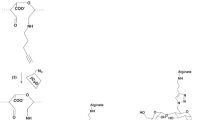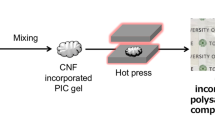Abstract
Natural macromolecules are attractive feedstocks to produce useful biomaterials. Our group has developed a process for the fabrication of free-standing films made of polyion complexes (PICs) of polysaccharides, such as chondroitin sulfate C (CS) and chitosan (CHI) (CS/CHI films), using hot press techniques. In this work, we report the preparation of molecularly imprinted CS/CHI films using methylene blue (MB), a small cationic dye, and the evaluation of the molecular permeability of the films for charged permeants in phosphate-buffered saline (PBS). The CS/CHI films with MB imprinting (MB-imprinted films) were evaluated by FT-IR measurements, zeta potential measurements, and electron microscopic observation. Comparison of MB permeability of the MB-imprinted films and nonimprinted films indicated that the imprinting effect was observed for the swollen films of polysaccharide PICs that maintained their morphologies by noncovalent interactions. To evaluate the effect of the permeant on the permeation behaviors, orange II (OR) and porphyrin derivatives were used as permeants. In the case of porphyrin derivatives, having larger sizes and more charges, the inner voids of the films were not significant for the permeation behavior, but the surface charges of the films were important. CHI coating on the MB-imprinted films was also performed to improve the permeation behavior of MB.
This is a preview of subscription content, access via your institution
Access options
Subscribe to this journal
Receive 12 print issues and online access
$259.00 per year
only $21.58 per issue
Buy this article
- Purchase on Springer Link
- Instant access to full article PDF
Prices may be subject to local taxes which are calculated during checkout







Similar content being viewed by others
References
Rinaudo M. Main properties and current applications of some polysaccharides as biomaterials. Polym Int. 2008;57:397–430.
Iijima K, Hashizume M. Application of polysaccharides as structural materials. Trends Glycosci Glycotechnol. 2015;27:67–79.
Sivasankarapillai VS, Das SS, Sabir F, Sundaramahalingam MA, Colmenares JC, Prasannakumar S, et al. Progress in natural polymer engineered biomaterials for transdermal drug delivery systems. Mater Today Chem. 2021;19:100382.
Khan MUA, Razak SIA, Arjan WSA, Nazir S, Anand TJS, Mehboob H, et al. Recent advances in biopolymeric composite materials for tissue engineering and regenerative medicines: a Review. Molecules. 2021;26:619.
Atanase LI. Micellar drug delivery systems based on natural biopolymers. Polymers. 2021;13:477.
Kokabi M, Sirousazar M, Hassan ZM. PVA–clay nanocomposite hydrogels for wound dressing. Eur Polm J. 2007;43:773–81.
Fwu-Long M, Shin-Shing S, Yu-Bey W, Sung-Tao L, Jen-Yeu S, Rong-Nan H. Fabrication and characterization of a sponge-like asymmetric chitosan membrane as a wound dressing. Biomaterials. 2001;22:165–73.
Ulubayram K, Cakar AN, Korkusuz P, Ertan C, Hasirci N. EGF containing gelatin-based wound dressings. Biomaterials. 2001;22:1345–56.
Stoica AE, Chircov C, Grumezescu AM. Nanomaterials for wound dressings: an up-to-date overview. Molecules. 2020;25:2699.
Shuai L, Xin L, Yanhan R, Penghui W, Yajie P, Rong Y, et al. Mussel-inspired dual-cross-linking hyaluronic acid/ε-Polylysine hydrogel with self-healing and antibacterial properties for wound healing. ACS Appl Mater Interfaces. 2020;12:27876–27888.
Hori Y, Winans AM, Irvine DJ. Modular injectable matrices based on alginate solution/microsphere mixtures that gel in situ and co-deliver immunomodulatory factors. Acta Biomater. 2009;5:969–82.
Water JJ, Schack MM, Velazquez-Campoy A, Maltesen MJ, van de Weert M, Jorgensen L. Complex coacervates of hyaluronic acid and lysozyme: Effect on protein structure and physical stability. Eur J Pharm Sci. 2014;88:325–31.
Coimbra P, Alves P, Valente TAM, Santos R, Correia IJ, Ferreira P. Sodium hyaluronate/chitosan polyelectrolyte complex scaffolds for dental pulp regeneration: synthesis and characterization. J Biol Macromol 2011;49:573–9.
Delair T. Colloidal polyelectrolyte complexes of chitosan and dextran sulfate towards versatile nanocarriers of bioactive molecules. Eur J Pharm Sci. 2011;78:10–18.
Lalevée G, Sudre G, Montembault A, Meadows J, Malaise S, Crépet A, et al. Polyelectrolyte complexes via desalting mixtures of hyaluronic acidand chitosan—Physicochemical study and structural analysis. Carbohydr Polym 2016;154:86–95.
Wuff G, Sarhan A. The use of polymers with enzyme-analogous structures for the resolution of racemate. J Angew Chem Int Ed. 1972;11:341–5.
Arshady R, Mosbach K. Synthesis of substrate-selective polymers by host-guest polymerization. Makromol Chem. 1981;182:687–92.
Vlatakis G, Andersson LI, Müller R, Mosbach K. Drug assay using antibody mimics made by molecular imprinting. Nature. 1993;361:645–7.
Lingxin C, Xiaoyan W, Wenhui L, Xiaqing W, Jinhua L. Molecular imprinting: perspectives and applications. Chem Soc Rev. 2016;45:2137–211.
Shea KJ, Spivak DA, Sellergren B. Polymer complements to nucleotide bases. selective binding of adenine derivatives to imprinted polymers. J Am Chem Soc. 1993;115:3368–9.
Hoshino Y, Kodame T, Okahata Y, Shea KJ. Peptide imprinted polymer nanoparticles: a plastic antibody. J Am Chem Soc. 1993;115:3368–9.
Hoshino Y, Kodame T, Urakami T, Kanazawa H, Kodama T, Oku N, et al. Recognition, neutralization, and clearance of target peptides in the bloodstream of living mice by molecularly imprinted polymer nanoparticles: a plastic antibody. J Am Chem Soc. 2010;132:6644–5.
Takeuchi T, Sunayama H. Beyond natural antibodies–a new generation of synthetic antibodies created by post-imprinting modification of molecularly imprinted polymers. Chem Commun. 2018;54:6243–51.
Rachel AH, Elena P, Thomas B, Geraint M, Nicholas T. Application of molecularly imprinted polymers in the anti-doping field: sample purification and compound analysis. Analyst. 2020;145:4716–36.
Tabkrich K, Angelica C, Loc TN. Epitope-imprinted polymers: applications in protein recognition and separation. RSC Adv. 2021;11:11403–14.
Myriam DÁ, Antonio ME. Molecularly imprinted polymer-quantum dot materials in optical sensors: an overview of their synthesis and applications. Biosensors. 2021;11:79.
Boysen RI, Schwarz LJ, Nicolau DV, Hearn MTW. Molecularly imprinted polymer membranes and thin films for the separation and sensing of biomacromolecules. J Sep Sci. 2017;40:314–55.
EL-Sharif HF, Hawkins DM, Stevenson D, Reddy SM. Determination of protein binding affinities within hydrogel-based molecularly imprinted polymers (HydroMIPs). Phys Chem Chem Phys. 2014;16:15483–9.
Armutcu C, Ozgür E, Çorman ME, Uzun L. Interface imprinted polymers with well-oriented recognition sites for selective purification of hemoglobin. Colloids Surf B: Biointerfaces. 2021;197:111435.
Perçin I, Idil N, Denizli A. Molecularly imprinted poly(N-isopropylacrylamide) thermosensitive based cryogel for immunoglobulin G purification. Process Biochem. 2019;80:181–9.
Lee SW, Ichinose I, Kunitake T. Molecular imprinting of azobenzene carboxylic acid on a TiO2 ultrathin film by the surface sol-gel process. Langmuir. 1998;14:2587–2563.
Hashizume M, Kunitake T. Preparation of self-supporting ultrathin films of titania by spin coating. Langmuir. 2003;19:10172–8.
Lee SW, Ahmed S, Wang T, Park Y, Matsuzaki S, Tatsumi S. et al. Label-free creatinine optical sensing using molecularly imprinted titanium dioxide-polycarboxylic acid hybrid Thin Films: a preliminary study for urine sample analysis. Chemosensors. 2021;9:185
Hashizume M, Kobayashi H, Ohashi M. Preparation of free–standing films of natural polysaccharides using hot press technique and their surface functionalization with biomimetic apatite. Colloids. Surf B. 2011;88:534–8.
Hashizume M, Ohashi M, Kobayashi H, Tsuji Y, Iijima K. Free-standing polysaccharide composite films: improved preparation and physical properties. Colloids Surf A: Physicochem Eng. 2015;483:18–24.
Iijima K, Tsuji Y, Kuriki I, Kakimoto A, Nikaido Y, Ninomiya R, et al. Control of cell adhesion and proliferation utilizing polysaccharide composite film scaffolds. Colloids Surf B: Biointerfaces. 2017;160:228–37.
Iijima K, Kimura T, Sato R, Takahashi T, Hashizume M. Kinetic analysis of molecular permeabilities of free-standing polysaccharide composite films. Macromol Chem Phys. 2017;218:1600391.
Yataka Y, Suzuki A, Iijima K, Hashizume M. Enhancement of the mechanical properties of polysaccharide composite films utilizing cellulose nanofibers. Polym J. 2020;52:645–53.
Decher GF. Nanoassemblies: toward layered polymeric multicomposites. Science. 1997;277:1232–7.
Li Y, Wang X, Sun J. Layer-by-layer assembly for rapid fabrication of thick polymeric films. Chem Soc Rev. 2012;41:5998–6009.
Hashizume M, Murata Y, Iijima K, Shibata T. Drug loading and release behaviors of freestanding polysaccharide composite films. Polym J. 2016;48:545–50.
Chen Y, Zhang Y, Feng X. An improved approach for determining permeability and diffusivity relevantto controlled release. Chem Eng Sci. 2010;65:5921–5.
Hoshino Y, Jibiki T, Nakamoto M, Miura Y. Reversible pKa modulation of carboxylic acids in temperature-responsive nanoparticles through imprinted electrostatic interactions. ACS Appl Mater Interfaces. 2018;10:31096–105.
Yabushita M, Kobayashi H, Hasegawa J, Hara K, Fukuoka A. Entropically favored adsorption of cellulosic molecules onto carbon materials through hydrophobic functionalities. ChemSusChem. 2014;7:1443–50.
Hoshino Y, Miyoshi T, Nakamoto M, Miura Y. Wide-range pKa tuning of proton imprinted nanoparticles for reversible protonation of target molecules via thermal stimuli. J Mater Chem B. 2018;5:9204–10.
Honda R, Gyobu T, Shimahara H, Miura Y, Hoshino Y. Electrostatic interactions between acid-/base-containing polymer nanoparticles and proteins: impact of polymerization pH. ACS Appl Polym Mater. 2020;3:3827–34.
Henderson L. Concerning the relationship between the strength of acids and their capacity to preserve neutrality. Am J Physiol. 1908;21:173–9.
Hasselbalch K. Die Berechnung der Wasserstoffzahl des Blutes aus der freien und gebundenen Kohlensäure desselben, und die Sauerstoffbindung des Blutes als Funktion der Wasserstoffzahl. Biochem Z. 1917;78:112–44.
Lee SB, Lee YM, Song KW, Park MH. Preparation and properties of polyelectrolyte complex sponges composed of hyaluronic acid and chitosan and their biological behaviors. J Appl Polym Sci. 2003;90:925–32.
Acknowledgements
This work was partially supported by Grants-in-Aid for Scientific Research (C) from MEXT, Japan (16K05799 and 19K05588 to MH). We thank Prof. Hidenori Otsuka (Tokyo University of Science) for the zeta potential measurements. We also thank Ms. Tamao Yamamoto (Tokyo University of Science) for the additional experiments.
Author information
Authors and Affiliations
Corresponding author
Ethics declarations
Conflict of interest
The authors declare that they have no conflict of interest.
Additional information
Publisher’s note Springer Nature remains neutral with regard to jurisdictional claims in published maps and institutional affiliations.
Supplementary information
Rights and permissions
About this article
Cite this article
Sagawa, T., Oishi, M., Yataka, Y. et al. Control of the molecular permeability of polysaccharide composite films utilizing a molecular imprinting approach. Polym J 54, 571–579 (2022). https://doi.org/10.1038/s41428-021-00605-9
Received:
Revised:
Accepted:
Published:
Issue Date:
DOI: https://doi.org/10.1038/s41428-021-00605-9



